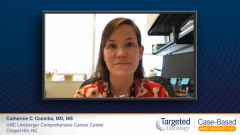
Considerations For Retreatment With Venetoclax in R/R CLL
Catherine Coombs, MD, MS, highlights available data and considerations for retreatment with venetoclax in the relapsed/refractory setting.
Episodes in this series

Catherine Coombs, MD, MS: When would I consider using venetoclax again versus selecting another treatment? I think that’s the key point in the case I presented. I think the answer is that it depends. The factors that would be important for me in my discussion with this patient are No. 1, what his preference is. No 2, how did he tolerate venetoclax the third time? Three, how long has it been since he first had venetoclax? A lot of us in the field are saying that 2 years may be an important inflection point. That’s probably based on older data of how well patients respond to retreatment with other agents. The published data for this are very sparse. I’ll briefly walk through 2 presentations that I’m aware of discussing this topic. I think more likely than not, the longer response a patient had across cancer treatments, venetoclax or other, the chances of them responding to the same treatment again are probably higher. But I don’t think we know that for a fact with venetoclax. I wouldn’t give a firm number of months where I think it would or wouldn’t be OK to retreat with venetoclax, provided that the patient didn’t have any serious adverse effects, tolerated it well, and it’s within their goals to be willing to do the ramp-up again for tumor lysis monitoring.
What data do we have regarding venetoclax retreatment? To my knowledge, there are 2 presentations from a prior ASH [American Society of Hematology] meeting, I think in 2020. One was looking at a substudy of the MURANO trial. As I mentioned, of course, the original intention of the MURANO trial was patients getting venetoclax for the first time. However, they had a substudy where patients could consent to getting retreated with venetoclax once they relapsed, and what it showed is that individuals do respond to venetoclax when exposed to it a second time. The response rate was 72%, but the numbers were really small. So that overall response rate amounts to 13 out of 18 patients responding to reintroduction of venetoclax. There’s not a lot of granularity to those data regarding the timing of how long their remission was. But it does show that re-exposure to venetoclax is a viable strategy for patients.
There was another presentation at that same ASH meeting using real-world data. This was presented by Meghan Thompson, [MD,] and Anthony Mato, [MD,] and a large, collaborative group of institutions. They actually had the same exact number of evaluable patients who got retreated with venetoclax, and they found the exact same overall response rate of 72%, so responses in 13 of 18 evaluable patients. The big difference between that study and the MURANO substudy is that the real-world study had patients who were pretty refractory, and most of them had had prior novel agent exposure. Looking to the MURANO trial, very few of those patients had prior novel agents. I think it was 10 or 15 who had prior BTK [Bruton tyrosine kinase] inhibitors. Most of those were post-chemotherapy, and then venetoclax was their second-line therapy. That is different with the real-world study, where patients had a quite a longer list of prior therapies.
It shows that venetoclax retreatment is very reasonable, but I think we need more prospective data regarding how long is too long or not long enough. Likely, I think longer remissions are better. I think that’s common sense. But could you retreat someone after a shorter interval? I think you could, but I think we need more prospective data. Matt Davids, [MD,] is doing a prospective trial on this. It’s one of my favorite named trials, it’s called ReVenG. The idea is to do a prospective study looking at repeated venetoclax and obinutuzumab for patients who relapsed following upfront venetoclax and obinutuzumab. They stratify patients based upon whether they have what’s considered a pretty good remission, which is over 2 years, versus shorter, which I believe they define as 1 to 2 years. I think we’ll get a wealth of information from that study. I don’t think we have that information yet.
Transcript edited for clarity.







































